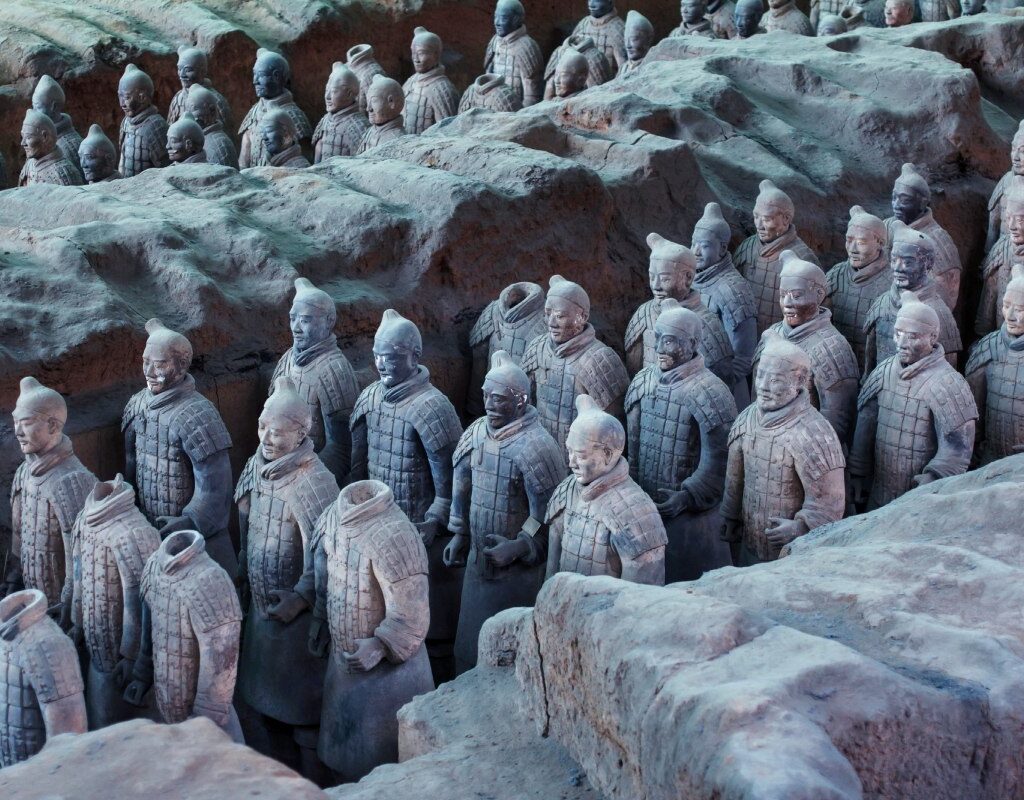Ancient China’s legacy of innovation is epitomized by the terracotta army of Qin Shi Huang. The standardization and organization of labor highlight an advanced understanding of production, echoing principles that would resonate with modern practices such as Toyotism.
The Industrial Revolution of Ancient China
In ancient China, a marvel of engineering and organization was born with the creation of the terracotta army for Qin Shi Huang’s mausoleum. This unprecedented project stood out for the standardization of each warrior and their arsenal of bronze weapons, achieving an astonishing level of uniformity.
The organization of labor played a crucial role in this achievement. By implementing autonomous productive cells, flexibility and efficiency in responding to the changing needs of the project were achieved, akin to today’s project teams.
These groups, made up of specialized craftsmen, worked closely together to manufacture different components of the weapons. This methodology not only optimized production but also ensured the high quality of each piece.
The identical shape, function, and chemical composition of the weapons demonstrated meticulous quality control and an advanced knowledge of metallurgy. Impressively, this organizational approach allowed for remarkable efficiency in a large-scale and complex project, anticipating production principles that would be recognized and applied thousands of years later in the modern world.
This strategy demonstrates that innovation and efficient work management are timeless concepts, applicable even in the most challenging circumstances.
Toyotism: The 2,200-Year Connection
The labor practices of artisans during the Qin Dynasty, especially in creating the terracotta army, set a remarkable precedent that resonates with modern Toyotism.
More than two millennia ago, these artisans implemented a production system where small teams worked autonomously, but in a coordinated manner, to manufacture weapons of great uniformity and exceptional quality.
This methodology echoes Toyota’s Just in Time system, where production is adjusted to current demand, reducing unnecessary storage and encouraging versatility among workers.
At Toyota, the teams’ ability to adapt to different tasks as needed maximizes efficiency and minimizes waste. This approach is not only economical but also creates a dynamic and rewarding work environment.
Employees develop diverse skills and contribute significantly to the final product, reinforcing the parallel with the practices of the Qin Dynasty.
This historical link underscores a vital lesson: the importance of adaptability and comprehensive team training. In a world characterized by constant change, strategies that promote a rapid reconfiguration of productive processes are not just desirable but necessary.
The experience with the Terracotta Warriors teaches us that work organization principles, applicable and valuable today, existed long before the industrial era and technological revolution.
Looking to the Past to Innovate the Future
Reflecting on the production system used for the Terracotta Warriors in ancient China highlights a fundamental principle: the importance of revisiting the past to discover innovative solutions to today’s challenges.
The implementation of autonomous productive cells and efficient resource management not only demonstrate an advanced understanding of labor organization but also present a model to follow in the current context, marked by rapid changes and fluctuating market demands.
Adaptability, versatile worker training, and a focus on quality and efficiency are principles that transcend the barriers of time and technology.
In an era where sustainability and resource optimization are imperatives, the lessons learned from the production of the terracotta army offer inspiration for modern businesses to reassess their work methods and team management.
The legacy of the Qin Dynasty artisans transcends their impressive work; it reminds us that innovation, regardless of the era, is the fruit of observation, adaptability, and the willingness to experiment with new models of organization and production.
The cover image has been provided courtesy of Depositphotos.com, a resource with more than 250 million photographs, music, and archive videos.





